 |
 |
 |
 |
 |
 |
| |
 |
|
 |
 |
 |
  |
  |
 |
 |
 |
 |
|
|
 |
|
 |
 |
 |
OPERA |
 |
|
 |
|
 |
 |
 |
| |
 |
| 
 |
Muzeum II Wojny Światowej
Museo della II Guerra Mondiale |
|
 |
 |
 |
 |
PROGETTISTA |
 |
|
|
 |
|
 |
 |
 |
| |
 |
|
 |
 |
 |
 |
CONTESTO |
 |
|
|
 |
|
 |
 |
 |
| Valenza dell'edificio nel territorio e nella città |
 |
|
 |
|
 |
 |
 |
 |
 |
 |
 |
DESCRIZIONE |
 |
|
|
 |
|
 |
 |
 |
|
|
 |
.jpg) Entering the Museum of The World War II competition in Gdansk we were fully aware of the problems that may occur during the design process as well as its interaction with the environment and very complicated functionality. Entering the Museum of The World War II competition in Gdansk we were fully aware of the problems that may occur during the design process as well as its interaction with the environment and very complicated functionality.
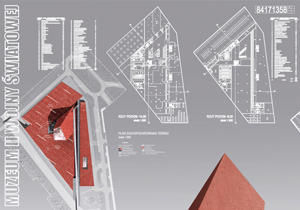 To fit in the historic part of the city, and creating a form that may become it's icon at the same time, we had to make a compromise between its forma and monumentality, being careful with its impudence and aggressiveness. We wanted the architecture to be a delicate suggestion rather than strong quotation for the World War II tragedy. That is how the idea of dynamic, expressive form had been brought to live, tearing apart the symbolic and dramatic shell covering the world, created by the war. The design of the form is to be undefined by one literally meaning. It may be discovered in many ways by each and every individual viewer. To fit in the historic part of the city, and creating a form that may become it's icon at the same time, we had to make a compromise between its forma and monumentality, being careful with its impudence and aggressiveness. We wanted the architecture to be a delicate suggestion rather than strong quotation for the World War II tragedy. That is how the idea of dynamic, expressive form had been brought to live, tearing apart the symbolic and dramatic shell covering the world, created by the war. The design of the form is to be undefined by one literally meaning. It may be discovered in many ways by each and every individual viewer.
Following the design process , we have agreed to leave most of the site as an open public space, so we moved some part of an exhibition underground. Entering the subterranean levels is to be a mood setting process. Starting from being unconcern and full of everyday thoughts, to be hanged in the balance and clear minded, to finally fell the horror, frightens and even pain by a strong relation with the exhibition. The underground part of the museum is a path through hell of war, a time travel experience. The "back to reality" begins with the ground level and the public space surrounding the museum, the place to think, to gather the experience from the underground. But that's not the end, the past is a creator of the future, so as the viewer climbs the tower to the very top, he sees hope and freedom, he sees an old and young town of Gdansk. He sees it having thoughts of the past he had just experienced. |
|
 |
 |
 |
|
 |
|
| Jury's verdict |
 |
|
 |
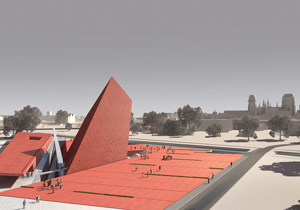 The Jury is of the opinion that the design selected in the Architectural Competition has every chance of becoming one of the most important features of the Gdańsk City Centre from the very beginning. In our belief it meets all conditions of joining in the sophisticated symbols in the future alongside the Armoury, St Mary’s Church, or the Crane. The Jury is of the opinion that the design selected in the Architectural Competition has every chance of becoming one of the most important features of the Gdańsk City Centre from the very beginning. In our belief it meets all conditions of joining in the sophisticated symbols in the future alongside the Armoury, St Mary’s Church, or the Crane.
The huge building tactfully merges in the neighbourhood sharing the chance of becoming an icon of Gdańsk with the major historic elements around. The minimalist means of architectural expression proposed by the authors gracefully blend the modern idea of the building with the historic background. In its Design, the innovative, huge-scale project makes use of the unique air of the city and transforms it in a modern manner. The colour and texture proposed in the design smoothly blend with the colours of Gdańsk giving the museum the power to pass the test of the 21.c century.
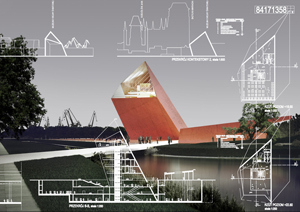 The design embraces an immense building, which serves varied purposes. Dynamic, huge in scale, the building carries an air of a sculpture created by the visitors. It rises symbolically from the ground, led by light, bold, Simple, and naked, symbolically placed in the geometry of the shipyard. It links the ground – its gloom, chill, and imprint of the Past, with the skies – hope, freshness, and Future. In this ingenious design, a rational vision of a public facility meets the wealth of history. It rings full sound, telling a story hard to chew for any generation, the story we must never forget. The attractive body of the building cumulates emotions, portrays the terror of war without depriving us of hope. It does not leave its interpreters buried in the gloom of the difficult topic. The design embraces an immense building, which serves varied purposes. Dynamic, huge in scale, the building carries an air of a sculpture created by the visitors. It rises symbolically from the ground, led by light, bold, Simple, and naked, symbolically placed in the geometry of the shipyard. It links the ground – its gloom, chill, and imprint of the Past, with the skies – hope, freshness, and Future. In this ingenious design, a rational vision of a public facility meets the wealth of history. It rings full sound, telling a story hard to chew for any generation, the story we must never forget. The attractive body of the building cumulates emotions, portrays the terror of war without depriving us of hope. It does not leave its interpreters buried in the gloom of the difficult topic.
The elegant pavilion, together with the obelisk nearby, squeezes into the ground and strikes the viewer with light, creating a symbol of catastrophe and the surviving hope. Phoenix-like, the building rises from Mother Earth, its ashes, towards the sky. The building will easily imprint itself on the visitors minds, conveying and being an unforgettable experience, both due to its interior and exterior. It will become a major feature on the plan of Gdańsk, perfectly composed in space.
The well-organised and modern building combines an immense range of functions . It offers huge space for permanent exhibitions, while remaining open for any displays in the future. The visitors to and the residents of the Tri-City will love it as an attraction. The designed tower will play a major role in gaining an image of the entire city, offering a fresh perspective view of Gdańsk, which will enhance the Museum’s valuable function of a viewing point.
As a public space, the Museum Has the potential of a meeting place for families, tourists, and acquaintances, of taking in dozens of cars. It incorporates an ingenious concept with functionality.
This exceptionally designed Museum of the Second World War will become a major attraction, telling the story of paramount importance for the humanity. It will grow to become a timeless symbol inscribed in the hearts of the people of Gdańsk, Poland, and Europe. |
|
 |
 |
 |
|
 |
|
| The Museum |
 |
|
 |
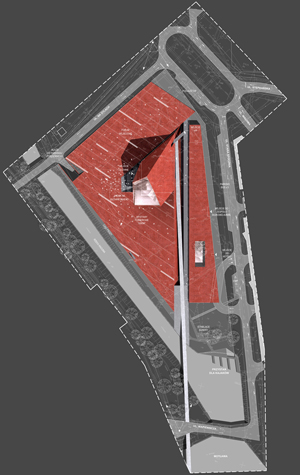 The Museum of the Second World War was formed on 26 November 2008 by virtue of the Ordinance of the Minister of Culture and National Heritage, Bogdan Zdrojewski. Gdańsk, the city where the war broke out, was selected to be the seat of the institution. The Museum of the Second World War was formed on 26 November 2008 by virtue of the Ordinance of the Minister of Culture and National Heritage, Bogdan Zdrojewski. Gdańsk, the city where the war broke out, was selected to be the seat of the institution.
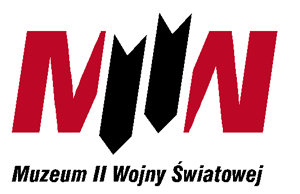 On 1 September 2008, Chairman of the Council of Ministers, Donald Tusk, appointed prof. dr hab. Paweł Machcewicz his Plenipotentiary for the Second World War Museum and entrusted him with the task of preparing the conceptual idea of the Museum. A year later, on Westerplatte, during the celebrations of the 70. anniversary of the outbreak of World War II, the Prime Minister signed the museum’s Deed of Foundation Laying and officially opened the open-air exposition entitled ‘Westerplatte: A Resort – Bastion – Symbol.’ On 1 September 2008, Chairman of the Council of Ministers, Donald Tusk, appointed prof. dr hab. Paweł Machcewicz his Plenipotentiary for the Second World War Museum and entrusted him with the task of preparing the conceptual idea of the Museum. A year later, on Westerplatte, during the celebrations of the 70. anniversary of the outbreak of World War II, the Prime Minister signed the museum’s Deed of Foundation Laying and officially opened the open-air exposition entitled ‘Westerplatte: A Resort – Bastion – Symbol.’
It is the mission of the Second World War Museum to create a modern outlet to tell the history of the war, the greatest cataclysm of the 20th century. This mission statement is perfectly valid considering that even though more than 70 years have passed since the outbreak of World War II there is no museum in Europe that would present a comprehensive view of the conflict, its development and nature.
The list of the museum’s top goals includes familiarising the world with the picture of the war, as experienced in Poland and other countries of Central and Eastern Europe. The experience is largely different and at the same time barely known to Western Europe or the world beyond. The historic facts will highlight the stories and fate of individual human beings, communities, and nations. The military events will be reduced to the background of the narration portraying everyday life of the civilians and soldiers, the terror of occupation, such phenomena as genocide, the resistance staged against the occupant, and the high level politics. The purpose of the approach is to visualise the unmet nature of the Second World War, which took the highest toll of the civilian population.
On 9 December 2009, a notarial deed concerning the building plot designated for the erection of the Museum of the Secord World War was ceremoniously signed at the Polish Post Museum in Gdańsk. The City authorities donated 1.7 ha of land worth over PLN 53 million to the Museum free of charge. Wałowa Street runs across a picturesque, even though slightly forgotten pocket of the Old Town of Gdańsk, neighbouring on the Radunia Canal embankment and in the immediate vicinity of the historic building of the Polish Post of the Free City of Gdańsk. |
|
 |
 |
 |
 |
 |
 |
 |
VIDEO |
 |
|
|
 |
|
 |
 |
 |
| |
 |
|
 |
 |
 |
 |
LOCALIZZAZIONE |
 |
|
|
 |
|
 |
 |
 |

|
 |

|
Continente |
|
 |
|
Nazione |
|
 |
|
Provincia |
|
 |
|
Distretto metropolitano |
|
 |
|
Città |
|
 |
|
Indirizzo |
|
 |
|
|
|
 |
|
Telefono |
|
 |
|
Fax |
|
 |
|
Sito web |
|
 |
|
E-mail |
|
 |
sekretariat@muzeum1939.pl |
|
 |
 |
 |
 |
MAPPA |
 |
|
|
 |
|
 |
 |
 |
| |
 |
|
 |
 |
 |
 |
|
TIPOLOGIA |
 |
|
|
 |
|
 |
 |
 |
Principale |
 |
|
 |
ARCHITETTURA | Musei ed edifici per esposizioni
Musei militari o di guerra
Arredo urbano e strutture per spazi pubblici
Aree pedonali, passeggiate
|
ARCHITETTURA DEL PAESAGGIO ED AMBIENTI NATURALI | Architettura del paesaggio
Piazze
| |
|
|
 |
|
Accessoria |
 |
|
 |
ARCHITETTURA | Edifici per attivita' culturali
Biblioteche e mediateche
Edifici per l'insegnamento
Auditorium
| |
 |
 |
 |
 |
CRONOLOGIA |
 |
|
|
 |
|
 |
 |
 |
Progetto |
 |
|
 |
| 
 |
2010
progetto vincitore di concorso
|
|
Realizzazione |
 |
|
 |
| 
 |
2012 - 2016 |
|
 |
 |
 |
 |
STAFF |
 |
|
|
 |
|
 |
 |
 |
|
 |
|
Gruppo di progettazione |
 |
Jacek Droszcz, Bazyli Domsta, Andrzej Kwieciński, Zbigniew Kowalewski
Kamil Domachowski, Maciej Busch |
|
Collaboratori |
 |
Krzysztof Kulawczuk, Izabela Gierada–Lipka, Magdalena Grabarczyk, Paweł Grabarczy,k Tomasz Rochna
Krzysztof Droszcz, Magdalena Landowska, Michał Kraska |
|
 |
 |
 |
 |
CREDITS |
 |
|
|
 |
|
 |
 |
 |
| |
 |
Images © Kwadrat
Text edited by Museum of the Second World War, Kwadrat
Courtesy of Museum of the Second World War
|
|
 |
  |
 |
|
|